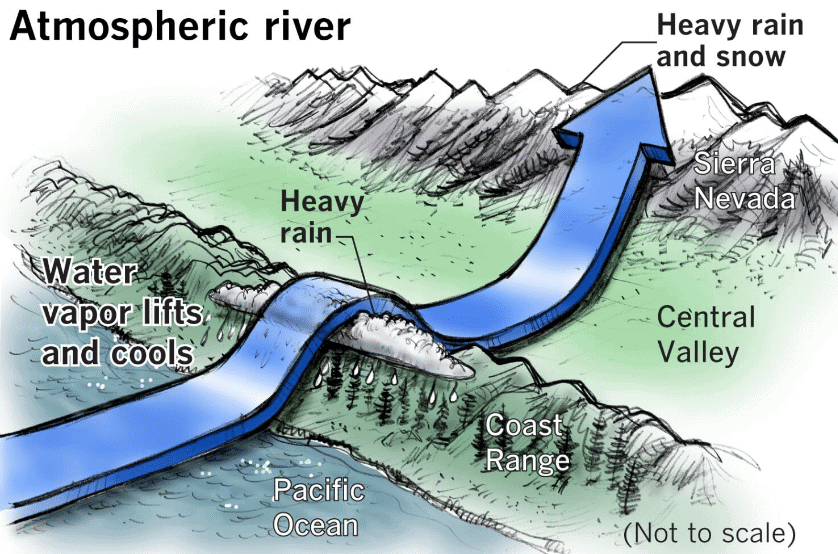UPSC Exam > UPSC Notes > Geography for UPSC CSE > Geography: April 2025 UPSC Current Affairs
Geography: April 2025 UPSC Current Affairs | Geography for UPSC CSE PDF Download
Atmospheric River

Why in News?
In April 2025, the United States faced significant weather disturbances characterized by heavy rainfall, strong winds, and severe thunderstorms. These conditions were attributed to a meteorological phenomenon known as an Atmospheric River (AR). The increasing frequency of such events has drawn attention to the impact of climate change on weather patterns.
Key Takeaways
- An Atmospheric River is a long, narrow band in the atmosphere that transports large amounts of water vapor from tropical oceans to continental areas.
- The 'Pineapple Express' is a notable example of AR storms that primarily affect the US West Coast, especially California.
Additional Details
- Characteristics:
- Shape & Size: ARs can extend up to 1,600 km in length and can vary from 400 to 600 km in width, as noted by the National Oceanic and Atmospheric Administration (NOAA).
- Moisture Content: They can carry water vapor equivalent to the average flow of the Mississippi River, with the most intense ARs transporting up to 15 times more.
- Categories of Atmospheric Rivers:
- Category 1 (Weak): Generally beneficial, aiding soil moisture and drought recovery.
- Category 2 (Moderate): Benefits reservoirs but can lead to localized flooding if rain persists.
- Category 3 (Strong): A mix of benefits and hazards; while it replenishes water supplies, it also poses flooding risks.
- Category 4 (Extreme): Predominantly hazardous, capable of causing severe flooding but can assist in drought recovery.
- Category 5 (Exceptional): Primarily hazardous, leading to catastrophic flooding and significant economic losses.
- Formation: ARs develop when warm ocean waters, particularly in tropical or subtropical regions, lead to high evaporation rates, which saturate the atmosphere with moisture. This moisture is then directed toward mid-latitudes by low-level jet streams and condenses into precipitation when it encounters mountains or fronts.
- Significance: Atmospheric Rivers play a crucial role in replenishing water supplies and contribute to over 90% of poleward water vapor transport in mid-latitudes. Their landfall can result in extreme precipitation.
- AR in India: Between 1951 and 2020, India recorded 596 major AR events, mostly during the summer monsoon. Significant floods, including the 2013 Uttarakhand floods and the 2018 Kerala floods, were linked to these events, which have become more frequent and severe in recent decades.
- Impact of Climate Change: Rising global temperatures are intensifying AR impacts. For every 1°C increase, air can hold approximately 7% more moisture, making storms fueled by ARs more potent. Future projections suggest that ARs will become longer, wider, and more intense, thereby doubling the occurrence of extreme AR events and heightening flood risks.
The increasing prevalence and intensity of Atmospheric Rivers underscore the need for enhanced understanding and preparedness against their potentially devastating impacts, particularly in vulnerable regions.
The document Geography: April 2025 UPSC Current Affairs | Geography for UPSC CSE is a part of the UPSC Course Geography for UPSC CSE.
All you need of UPSC at this link: UPSC
|
263 videos|872 docs|232 tests
|
FAQs on Geography: April 2025 UPSC Current Affairs - Geography for UPSC CSE
| 1. What is an atmospheric river and how does it affect weather patterns? |  |
Ans. An atmospheric river is a narrow corridor of concentrated moisture in the atmosphere, often leading to significant rainfall when it makes landfall. These weather systems can transport large amounts of water vapor from tropical regions to higher latitudes, causing heavy precipitation, flooding, and even landslides in affected areas.
| 2. What are the potential impacts of atmospheric rivers on agriculture and water resources? |  |
Ans. Atmospheric rivers can have both positive and negative impacts on agriculture and water resources. On one hand, they can provide much-needed rainfall to drought-stricken areas, replenishing reservoirs and supporting crop growth. On the other hand, excessive rainfall can lead to flooding, soil erosion, and damage to crops, negatively impacting agricultural productivity.
| 3. How can atmospheric rivers contribute to climate change? |  |
Ans. Atmospheric rivers are influenced by climate change, as rising temperatures can increase the amount of moisture the atmosphere can hold. This can lead to more intense and frequent atmospheric river events, which in turn can exacerbate flooding and other weather-related disasters, creating a feedback loop that further impacts climate patterns.
| 4. What measures can be taken to mitigate the risks associated with atmospheric rivers? |  |
Ans. To mitigate the risks associated with atmospheric rivers, authorities can invest in improved forecasting and early warning systems, enhance stormwater management infrastructure, and develop land-use planning strategies that consider flood risks. Public education about the potential impacts of atmospheric rivers can also help communities prepare and respond effectively.
| 5. How do atmospheric rivers differ from traditional storm systems? |  |
Ans. Atmospheric rivers differ from traditional storm systems in their structure and function. While traditional storms often result from frontal systems and can be more widespread, atmospheric rivers are characterized by their concentrated moisture transport and can produce localized heavy rainfall over short periods, leading to rapid flooding and other associated hazards.
Related Searches





















